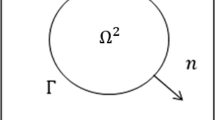Abstract
The creep of a skin layer under a distributed surface pressure was solved by an analytical method using Hankel transform and Laplace transform. The surface stress boundary conditions lead to a Volterra integral equation of the first kind, which was then solved by a numerical method. The IMSL subroutines DINLAP and DGQRUL were employed to numerically obtain the Hankel-Laplace inversion. The calculated displacements at two distinctive moments were compared respectively with those obtained by an elastic solution for either incompressible or compressible solid. The transient creep responses of the skin layer were also presented.
Similar content being viewed by others
References
Torzilli, P. A. and V. C. Mow. On the fundamental fluid transport mechanisms through normal and pathological articular cartilage during function. Part 15 The analysis, solution and conclusions.J. Biomechanics. 9 (1976), 587–606.
Mow, V. C. and J. M. Mansour. The nonlinear interaction between cartilage deformation and interstitial fluid flow.J. Biomechanics,10, (1977), 31–39.
Mow, V. C., S. C. Kuei, W. M. Lai and C. G. Armstrong. Biphasic creep and stress relaxation of articular cartilage in compression: Theory and experiments.J. Biomechanical Engineering.102 (1980), 73–84.
Mow, V. C., M. K. Kwan, W. M. Lai and W. H. Holmes, A finite deformation theory for nolinear permeable soft hydrated biological tissues, inFrontiers in Biomechanics, ed. by G. W. Schmid-Schonbein, S. L. Y. Woo, and B. W. Zweifach, Springer-Verlag (1986).
Bowen, R. W., Theory of mixtures,Continuum Physics.III, ed. by A. C. Eringen, Academic Press, New York (1976).
Crane, R. F., A. E. Green and P. M. Naghdi, A mixture of viscoelastic materials with different constituent temperatures.Quart. J. Mech. Appl. Math.,23, (1970), 171–184.
Green, A. E. and P. M. Naghdi. The flow of fluid through an elastic solid.Acta Mech.,9 (1970), 323–340.
Mak, A. F. T., W. M. Lai and V. C. Mow, Biphasic indentation of articular cartilage. Part I: Theoretical analysis.J. Biomechanics,20 (1987), 703–714.
Monanee, J. and R. E. Gibson, Displacement functions and linear transforms applied to diffusion through porous elastic media,Quart J. Mech. Appl. Math.,13 (1960), 98–111.
Poulos, H. G. and F. H. Davis,Elastic Solutions for Soil and Rock Mechanics. Wiley (1974).
Sneddon, I. N.,Fourier Transforms, McGraw-Hill, New York (1951).
Chien Wei-zang and Yeh Kai-yuan.Elastic Mechanics, Science and Technology Press of China, Beijing (1980). (in Chinese).
Author information
Authors and Affiliations
Additional information
Communicated by He Fu-bao
Rights and permissions
About this article
Cite this article
Li-du, H., Qin-que, W. & Arthur, M.Ft. A mixed method for the creep of a skin layer. Appl Math Mech 15, 1131–1138 (1994). https://doi.org/10.1007/BF02451984
Received:
Issue Date:
DOI: https://doi.org/10.1007/BF02451984




